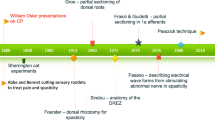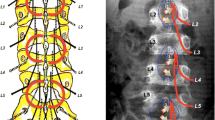Abstract
Selective functional posterior rhizotomy (SFPR) is a popular operation for the treatment of spasticity in children with cerebral palsy, but the physiologic basis of the procedure is poorly understood. As part of SFPR operations in 60 consecutive children, the responses to electrical stimulation of posterior lumbosacral roots and rootlets, and the corresponding anterior roots were studied. In addition, similar electrical stimulation of posterior roots was performed in four nonspastic “control” children. Sustained responses to 50 Hz stimulation, one of the criteria used to signify abnormality in the spastic children, was found frequently in the “control” children. Contralateral spreal to the lower limb muscles and suprasegmental spread to the upper limbs, face, and neck were determined to be the most valid criteria which differentiated abnormal from normal responses. Stimulation of anterior nerve roots at 50 Hz caused sustained responses and ipsilateral lower limb spread, at a low threshold compared to that of corresponding posterior roots. The results of this study bring into question the validity of some of the criteria that are used to select abnormal posterior rootlets in the SFPR procedure, and suggest criteria that may be more valid based on findings in nonspastic children.
Similar content being viewed by others
References
Abbott R, Forem SL, Johann M (1989) Selective posterior rhizotomy for the treatment of spasticity: a review. Child's Nerv Syst 5:337–346
Coggeshall RE (1979) Afferent fibers in the ventral root. Neurosurgery 4:443–448
Coggeshall RE, Applebaum ML, Fazen M, Stubbs TB, Sykes MT (1975) Unmyelinated axons in human ventral roots, a possible explanation for the failure of dorsal rhizotomy to relieve pain. Brain 98:157–166
Cohen AR, Webster HC (1991) How selective is selective posterior rhizotomy? Surg Neurol 35:267–272
Decandia M, Provini L, Taborikova H (1967) Mechanisms of the reflex discharge depression in the spinal motoneuron during repetitive orthodromic stimulation. Brain Res 4:284–291
Fasano VA, Barolat-Romana G, Ivaldi A, Sguazzi A (1976) La radicotomie postérieure fonctionelle dans le traitement de la spasticité cérébrale. Neurochirurgie 33:23–34
Fasano VA, Broggi G, Barolat-Romana G, Sguazzi A (1978) Surgical treatment of spasticity in cerebral palsy. Child's Brain 4:289–305
Fasano VA, Broggi G, Zeme S (1988) Intraoperative electrical stimulation for functional posterior rhizotomy. Scand J Rehabil Med Suppl 17:149–154
Futagi Y, Abe J (1985) H-reflex study in normal children and patients with cerebral palsy. Brain Dev 7:414–420
Futagi Y, Abe J, Tanaka J, Okamoto N, Ikoma H (1988) Recovery curve of the H-reflex in normal infants, central coordination disturbances cases and cerebral palsy patients within the first year of life. Brain Dev 10:8–12
Lazareff JA, Macta-Acosta AM, Garcia-Mendez MA (1990) Limited selective posterior rhizotomy for the treatment of spasticity secondary to infantile cerebral palsy: a preliminary report. Neurosurgery 27:535–538
Mayer RF, Mosser RS (1969) Excitability of motorneurons in infants. Neurology 19:932–945
Peacock WJ, Arens LJ (1982) Selective posterior rhizotomy for the relief of spasticity in cerebral palsy. S Afr Med J 62:119–124
Peacock WJ, Arens LJ, Berman B (1987) Cerebral palsy spasticity. Selective posterior rhizotomy. Pediatr Neurosci 13:61–66
Storrs BB, Nishida T (1988) Use of the ‘H’ reflex recovery curve in selective posterior rhizotomy. Pediatr Neurosci 14:120–123
Vaughan CL, Berman B, Peacock WJ (1991) Cerebral palsy and rhizotomy. A 3-year follow-up evaluation with gait analysis. J Neurosurg 74:178–184
Author information
Authors and Affiliations
Rights and permissions
About this article
Cite this article
Steinbok, P., Langill, L., Cochrane, D.D. et al. Observations on electrical stimulation of lumbosacral nerve roots in children with and without lower limb spasticity. Child's Nerv Syst 8, 376–382 (1992). https://doi.org/10.1007/BF00304784
Received:
Issue Date:
DOI: https://doi.org/10.1007/BF00304784




